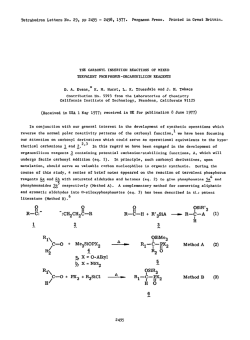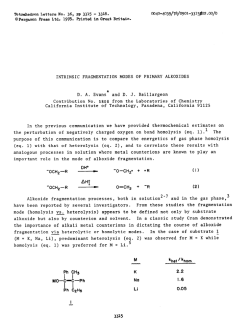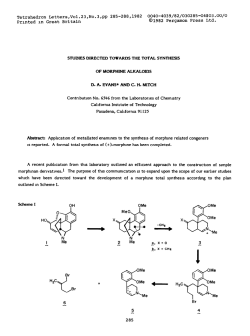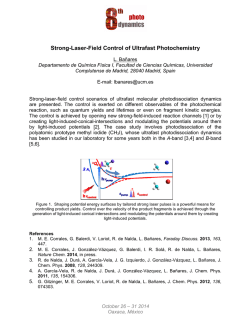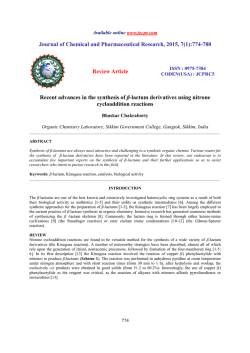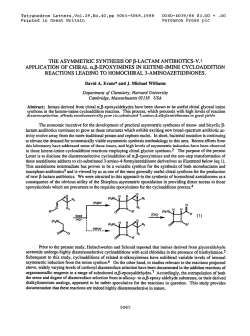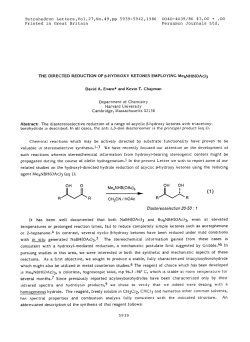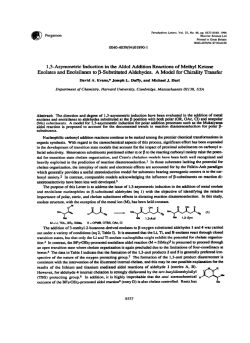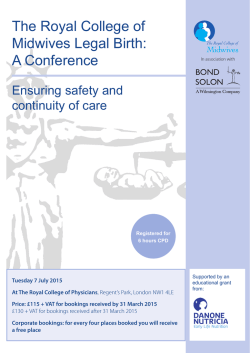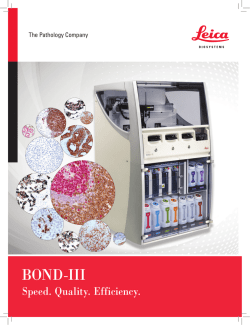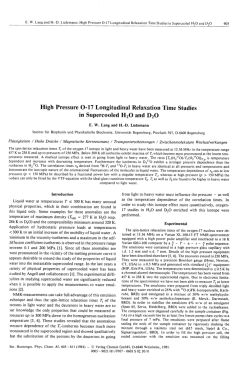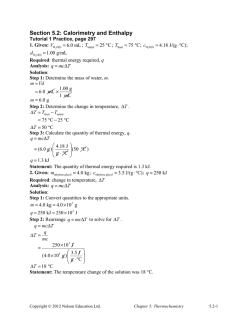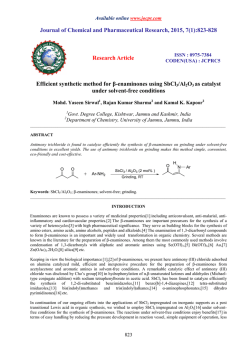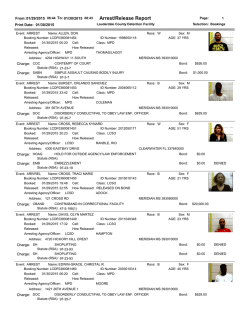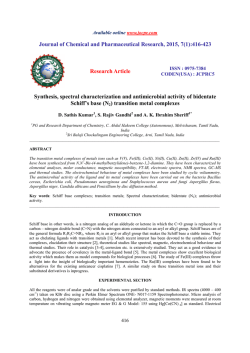
PII: S0040-4039(01)85627-6
Tetrahedron LettersNo. 36, pp 3319 - 3322. OPergamonPress Ltd. 1978. Printedin Great Britain. ALKOXIDE SUBSTITUENT EFFECTS ON CARBON-CARBON BOND HOMOLYSIS D. A. Evans* and D. J. Baillargeon Contribution No. 5781 from the Laboratories of Chemistry California Institute of Technology, Pasadena, California 91125 Recent publications from our laboratory have demonstrated that [3,3]-sigmatropic rearrangements (eq. 1) exhibit dramatic progressive rate acceleration, without any apparent change in mechanism, as the donor properties of the oxygen substituent are increased (M = H - M = K).ls2 These observations have stimulated others to explore the possibility of promoting related [1,3]-sigmatropic processes (eq. 2).3p4 Coincident with the above studies, Franzus and Krow6 have independ- ently reported examples of facile [1,3]-sigmatropic rearrangements which are strongly promoted by charged heteroatom substituents (eq. 3, eq. 4 respectively). c Mo \ c3.33_ MO (II / ‘3 Cl,33 H / C (2) OM OM ct,33_ (3) d‘/ I \\NM 0, & CL33_ MN zb \ \ / Similar to sigmatropic rearrangements in neutral molecules, rearrangements I in charged systems may proceed via concerted or stepwise radical pathways. 3319 Unfortunately, no information is available on the perturbation of charged oxygen and nitrogen substituents on adjacent bond strengths (eq. 5, 6; X=O,N). We have thus attempted to estimate the gas phase bond dissociation energies DHS of DH; H--X-; H--X-_C--R + R. (5) + R. (6) \ DH2” =-_ - :X+-R - :x-C; several alkoxides and to compare such values with the corresponding bond energy data DHi for alcohols. The resulting difference in bond energies is a measure of the substituent effect of O-. Accordingly, we have established a simple BornHaber cycle (Scheme I) which provides gas-phase bond dissociation energies DH; for primary alkoxide ions, R = H, CH3, CH2CH=CH2. Scheme I DH” -0-CH,-R - -0--i;H, + *R AH; ‘0-CH2-R DH”(6CH2- O=CH, R) = EA(6CH2R) - EA(CH20) + .R + DH”(bCH2-RR) The limitation associated with this and related calculations is the availability of reliable gas phase thermochemical data for the illustrated processes. From the recent work of Mclver and of Hamill, the gas phase electron affinities (EA) of simple alkoxy radicals are available, AH: = EA(RO*).8yg A few bond dis- sociation energies DH"(-0CH2 -R) have either been determined or can be estimated. 10,12 Experimentally determined EA's for aliphatic carbonyl compounds, AH; = -EA(RR'C=O), are generally unavailable. However, recent electron transmission spectroscopic studies on formaldehyde provide the most reliable measurement for its EA (-15.2 kcal/mol).13 The calculated values for DH"(bCH2-R), 10,14 and substituent effects are shown in literature values for DH"(HOCH2-R), Table I. The data in Table I suggest that the effect of O- in promoting bond homely, sis is quite significant, AD = 13-17 kcal/mol. The origin of this observed bond weakening is differential stabilization of the radical by overlap with orbitals No. 36 3321 Table I. Calculated and Bond Dissociation Substituent Effects XCH,-R R Energies of -OCH,-R for:a - XCH2* DH”(HOCH,-R) + *R b DH”@CH2-R) AD H 93c 76 17 CM3 83c 68 15 CH2CH=CH2 71d 58 13 ‘All values dRef. reported in kcal/mol. bGas phase, 29EPK. CRef. IO. 14. via a two-center three-electron bond 15 At this point one is better in .CH2-O- (.CH2-O- CH2kO) than in *CH20H. + can only speculate on the effects of counterions, M+ (Li , Na +, K+), on It is predicted, however, that electrostatic effects of M+ will DH" (MOCH2-R) . of the two oxygen species. Delocalization cause a greater net stabilization of the charge-localized alkoxide than of the charge-delocalized ketyl. These projections are consistent with the observation! dissociation constant! of Hirota on the counterion effects on pinacolate eketyl (eq. 7, R.= fluorenyl).16 Qualitatively, Kd increases with decreasing alkali metal electronegativity R\ /R R/ ‘R MO-C-C-OM a At the present time, no quantitative (Li > Na > K). R\ Kd (7) 2 x R;c-oM H : OLi 1 ; I 50°C/3 hr g [ (?;;I = ($1; (8) OLi 3 estimates can be made for the counterion effects on DH"(MOk-R). reactions proceeding through proposed ketyl intermediates (eq. 8) 18 critically re-examined to exclude other reasonable mechanisms. Consequently, 17 should be Over the years there has accumulated a substantial body of data which 19 indicates that methoxide ion is an effective hydrogen atom donor (es. 9). The data in Table I suggest that methoxide ion [DH"(&ZHZ-H) = 76 kcal/moll could be a better hydrogen atom donor than thiols [DH"(CHSS-H) = 88 kcal/mo1141 which are commonly employed hydrogen atom transfer substrates. 3322 No. 36 R. t CH30- - R-H + .CH20- (9) The large magnitude of alkoxide substituent effects is in striking contrast to the initial intuitive prediction of many chemists that the effect would be small; however, the thermochemical values calculated above are consistent with recent experimental evidence. l-5,19 Acknowledgement. Support from the National Science Foundation is gratefully ..~-_5~1~11..1-.-_.-acknowledged. The authors wish to thank Professors J.L. Beauchamp, W.A. Goddard, III and S.W. Benson for stimulating discussions on this topic. 1. 2. 3. 4. REFERENCES D.A. Evans and A.M. Golob, J. Am. Chem. Sot., !33, 4765 (1975). D.A. Evans, D.J. Baillargeon and J.V. Nelson, ibid ., ,l,o_O, 2242 (1978). R.W. Thies and E.P. Seitz, J. Org. Chem., _4_3,1050 (1978); S.R. Wilson, D.T. Mao, K.M. Jernberg and S.T. Ezmirly, Tetrahedron Lett., 2559 (1977). 5. T. Miyashi, A. Hazato and T. Mukai, J. Am. Chem. Sot., __-_ 100, 1008 (1978). B. Franzus, M.L. Scheinbaum, D.L. Waters and H.B. Bowlin, ibid., _9_8, 1241 (1976). 6. G.R. Krow and J. Reilly, ibid., '33, 3837 (1975). 7. The alternate ionic pathway is discussed in: D.A. Evans and D.J. Baillargeon, Tetrahedron Lett ., 0000 (1978). 8. J.E. Bartmess and R.T. McIver, Jr., ibid., 99, 4163 (1977). Values for EA(RO*) in kcal/mol follow: EA(CH30T39, EA(Et0.) = 40, EA(CH2=CHCH2CH20. aEA(n-C4H90.) = 44 (ref. 9). 9. J.M. Williams and W.H. Hamill, J. Chem. Phys., 43, 4467 (1968). 10. J.A. Kerr, Chem. Rev., 66, 465 (1966); S.W. Benson, J. Chem. Ed., 42, 502 (1965). Values for DH'-(.OCH2-R) in kcal/mol follow: DH"(.OCH -H) =-22; DH"(*OCH2-CH3) = 13; DH'(sOCH2-CH2CH=CH2) estimated to be -1 based upon AHf"(*OCH2CH2CH=CH2) z 16 kcal/mol, AHf“(CH2=0) = -26 kcal/mol (ref. ll), AHf"(*CH2CH=CH2) = 41.2 kcal/mol (ref. 12). 11. J.D. Cox and G. Pilcher, "Thermochemistry of Organic and Organometallic Compounds," Academic Press, New York, 1970. 12. D.M. Golden, N.A. Gac and S.W. Benson, J. Am. Chem. Sot., 91, 2136 (1969). 13. 15. E.H. Van Veen, W.L. Van Dijk and H.H. Brongersma, Chem. Phys., 16, 337 (1976) R.T. Sanderson, "Chemical Bonds in Organic Compounds," Sun and Sand Publishing Co., Scottsdale, Arizona, 1976. W.A. Goddard, III, M.L. Steigerwald, and D.A. Evans, unpublished results. 16. N. Hirota and S.I. Weissman, J. Am. Chem. Sac., _8$, 2538 (1964). 17. M. Schlosser and P. Weiss, Synthesis, 257 (1970). J.E. McMurry and W. Choy, J. Org. Chem., 42, 1800 (1978); equilibration ,1-,2 was found to proceed via a redox process. J.A. Zoltewicz, T.M. Oestreich and A.A. Sale, J. Am. Chem. SOC., $!z, 5889 (1975); M.A. Shippey and P.B. Dervan, J. Ore. Chem., 42, 2654 (1977) and references cited therein. 14. 18. 19. (Receivedin USA 15 June 1978; receiveiin UK for publication4 July 1978)
© Copyright 2024

